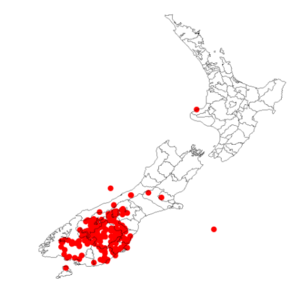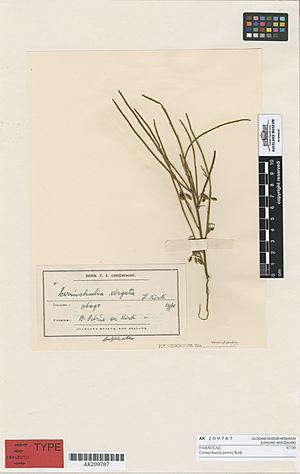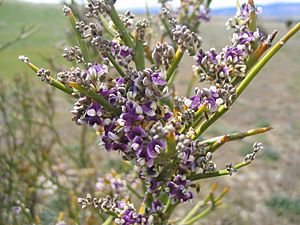Carmichaelia petriei facts for kids
Quick facts for kids Carmichaelia petriei |
|
|---|---|
 |
|
| Conservation status | |
|
Invalid status (NZ TCS)
|
|
| Scientific classification | |
| Kingdom: | |
| (unranked): | |
| (unranked): | |
| (unranked): | |
| Order: | |
| Family: | |
| Subfamily: | |
| Tribe: | |
| Subtribe: |
Astragalinae
|
| Genus: | |
| Species: |
C. petriei
|
| Binomial name | |
| Carmichaelia petriei Kirk, 1899
|
|
 |
|
| Occurrence data from AVH | |
| Synonyms | |
|
|
Carmichaelia petriei is a special type of plant called a New Zealand broom. It belongs to the Carmichaelia family. This plant is found only in New Zealand, which means it is endemic to this country. It might even be a very important plant for a tiny, critically endangered insect called the fungus weevil Cerius otagensis.
Contents
Discovering and Naming Carmichaelia petriei

This unique plant was first described by a botanist named Thomas Kirk. He wrote about it in his book, The students' flora of New Zealand and the outlying islands, in 1899.
Kirk named the plant to honor Donald Petrie. Petrie was the person who first discovered this species. You can find an original plant sample, called an isolectotype, of C. petriei at the Auckland War Memorial Museum.
What Does Carmichaelia petriei Look Like?
C. petriei is a strong, upright shrub. It can grow quite tall, up to 2.5 meters (about 8 feet) high and 2 meters (about 6.5 feet) wide. It doesn't have many branches.
Its branches are usually green, yellow-green, or bronze-green. They don't have leaves. The plant's flowers are beautiful, colored violet, purple, and white. You can see them blooming from November to January.
After flowering, the shrub produces seeds from January to May. You can tell C. petriei apart from other Carmichaelia species by its seed pods. These pods hang down as they get ripe, and the seeds fall off when they are ready.
Where Does Carmichaelia petriei Grow?
This plant is found only in New Zealand. It grows in the South Island. You can find it as far north as the upper part of the Waitaki River Valley in Canterbury. It also lives in the MacKenzie Basin, Otago, and Southland, including Stewart Island.
Where Does Carmichaelia petriei Live?
C. petriei likes to grow in areas with scrub and tussock grassland. It often grows among rocks. You can find it in different types of places, including mountainous areas, lowlands, or near the coast.
It also likes to live in river gorges, on terraces, cliffs, and at the edges of forests.
Why is Carmichaelia petriei Important?
This plant might be a host plant for a very rare insect. One of only four known specimens of the critically endangered fungus weevil Cerius otagensis was found on a C. petriei plant.
This suggests that C. petriei could be a vital food source or home for this endangered weevil. Protecting this plant might help protect the weevil too.
How is Carmichaelia petriei Being Protected?
For a long time, C. petriei had many plants and was considered "Not Threatened" by the Department of Conservation (DOC) in 2013. This meant it was not in danger.
However, in 2017, its status changed. It was reclassified as "At Risk - Declining." This means that its population is now getting smaller, and it needs more attention to ensure its survival.


